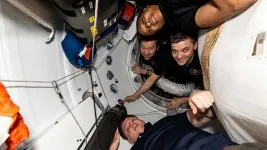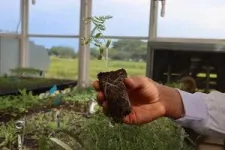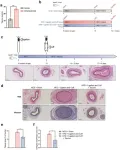(Press-News.org) KENNEDY SPACE CENTER (FL), October 25, 2024–After seven months of living and working onboard the International Space Station (ISSInternational Space Station), astronauts of NASA’s eighth rotational SpaceX crew mission (Crew-8) splashed down safely off the coast of Florida. The mission, which is part of NASA’s Commercial Crew Program, included NASANational Aeronautics and Space Administration astronauts Matthew Dominick, Michael Barratt, and Jeanette Epps, as well as Roscosmos cosmonaut Alexander Grebenkin. During their mission on station, the three NASA astronauts supported dozens of research investigations sponsored by the ISS National Laboratory®.
These investigations spanned many areas, including in-space production applications(Abbreviation: InSPA) InSPA is an applied research and development program sponsored by NASA and the ISS National Lab aimed at demonstrating space-based manufacturing and production activities by using the unique space environment to develop, test, or mature products and processes that could have an economic impact., life and physical sciences, and technology development, all aimed at bringing value to humanity and enabling a robust market in low Earth orbit(Abbreviation: LEO) The orbit around the Earth that extends up to an altitude of 2,000 km (1,200 miles) from Earth’s surface. The International Space Station’s orbit is in LEO, at an altitude of approximately 250 miles. (LEO).
Below highlights a few of the ISS National Lab-sponsored projects the Crew-8 NASA astronauts worked on during their mission.
Several investigations focused on in-space production applications, an increasingly important area of emphasis for the ISS National Lab and NASA.
A project from Cedars Sinai Medical Center aims to establish methods to support the in-space manufacturing of stem cells, which can be matured into a wide variety of tissues. These methods will be used for future large-scale in-space biomanufacturing of stem cell-derived products, which could lead to new treatments for heart disease, neurodegenerative diseases, and many other conditions.
Redwire Corporation partnered with Eli Lilly and Company and Butler University on a series of investigations leveraging Redwire’s Pharmaceutical In-space Laboratory (PIL-BOX), a platform to crystallize organic molecules in microgravityThe condition of perceived weightlessness created when an object is in free fall, for example when an object is in orbital motion. Microgravity alters many observable phenomena within the physical and life sciences, allowing scientists to study things in ways not possible on Earth. The International Space Station provides access to a persistent microgravity environment.. Results from this research could lead to improved therapeutics to treat an array of conditions. These projects continue Eli Lilly’s space journey, as the company has launched multiple investigations to the orbiting laboratory over the years for the benefit of patient care on Earth.
The astronauts supported the third experiment in a series of projects from the University of Notre Dame to improve ultra-sensitive biosensors. The biosensors can detect trace substances in liquids, including early cancer biomarkers. By using laser heating to control bubble formation in microgravity, the team improved particle collection—a key step in boosting sensor sensitivity. This research, funded by the U.S. National Science Foundation, could transform early and asymptomatic cancer detection and other medical diagnostics.
The crew conducted phase two of a technology development project from Sphere Entertainment to test Big Sky—the company’s new ultra-high-resolution, single-sensor camera—on the space station. In the first phase of the project, which launched in November 2022, astronauts tested a commercial off-the-shelf camera on the ISS to collect baseline information. During the second phase, the astronauts tested Big Sky to validate the camera’s function, operations, and video downlink capabilities in microgravity. Big Sky is being developed by Sphere Entertainment to capture content for Sphere, the next-generation entertainment medium in Las Vegas.
In the final days before their departure from the space station, the Crew-8 astronauts supported projects that recently launched on NASA’s ninth rotational crew mission (Crew-9).
One is a student-led project from Isabel Jiang, a recent high school graduate from Hillsborough, CA, who is now in her first year at Yale. Jiang is the winner of the 2023 Genes in Space student research competition, founded by Boeing and miniPCR bio and supported by the ISS National Lab and New England Biolabs. Jiang’s experiment investigates the effect of radiation and the space environment on mechanisms for gene editing. Results could help develop methods to better protect astronauts and shed light on genetic risks for certain diseases during spaceflight.
Another is an investigation from the U.S. Air Force Academy and Rhodium Scientific to compare the root growth of Arabidopsis plants, a member of the mustard family, at two different orbital altitudes. Plants grown on the space station in LEO for four to six days will be compared with similar plants grown on the recent Polaris Dawn mission, which flew in the same type of vehicle at a higher orbit for approximately the same amount of time. Results could provide insights into the production of crops for long-duration space missions and in high-radiation environments.
These are just a few of the ISS National Lab-sponsored research projects conducted on the space station during this expedition. To learn more about these investigations and others, visit our launch page.
Download a high-resolution image for this release: SpaceX Crew-8
END
Astronauts return to Earth following seven-month science expedition on International Space Station
NASA’s SpaceX Crew-8 astronauts supported a variety of ISS National Lab-sponsored investigations including in-space manufacturing, cancer treatments, and genetic research
2024-10-25
ELSE PRESS RELEASES FROM THIS DATE:
Alliance Bioversity-CIAT inaugurates the most advanced respirometry chambers in Latin America to measure methane emissions from livestock
2024-10-25
The most advanced respirometry chambers in Latin America were inaugurated at the Alliance Bioversity-CIAT campus in Colombia. These are hermetically sealed spaces designed to precisely measure and analyze the concentrations of gases, such as methane and carbon dioxide, produced by animals.
This advance is part of the Low-Methane Forages, project led by the Alliance Bioversity-CIAT in collaboration with the CGIAR research centers ILRI and ICARDA and their Germplasm Banks.
The project is evaluating thousands of forage ...
Study finds bariatric surgery declined with rise in GLP-1 drugs to treat obesity
2024-10-25
Researchers from Mass General Brigham and collaborators found that use of GLP-1 drugs to treat obesity more than doubled from 2022 to 2023 while rates of surgery dropped by one quarter.
KEY TAKEAWAYS
Researchers from Mass General Brigham and collaborators assessed national trends in the number of patients with obesity prescribed GLP-1 drugs and the number who underwent metabolic bariatric surgery.
Researchers documented a 132.6% increase in patients prescribed GLP-1 drugs between 2022 and 2023, and a 25.6% decrease in patients undergoing bariatric ...
UMD researcher trains AI to predict diarrheal outbreaks related to climate change
2024-10-25
Climate change-related extreme weather, such as massive flooding and prolonged drought, often result in dangerous outbreaks of diarrheal diseases particularly in less developed countries, where diarrheal diseases is the third leading cause of death among young children. Now a study out Oct. 22, 2024, in Environmental Research Letters by an international team of investigators led by senior author from University of Maryland’s School of Public Health (UMD SPH) Amir Sapkota, offers a way to predict the risk of such deadly outbreaks ...
Researchers discover that errors in protein location are a common cause of disease
2024-10-25
The team developed a high-throughput imaging platform to assess the influence of nearly 3,500 mutations on protein location. They found that roughly one in six disease-causing mutations led to proteins ending up in the wrong location in the cell.
“Technological advances in genetic sequencing have allowed researchers to identify thousands of protein mutations that cause disease,” said Jessica Lacoste, co-lead author on the study and postdoctoral fellow at U of T’s Donnelly Centre for Cellular and Biomolecular Research. “We are now able to ...
Aston University researcher develops new optical technique that could revolutionise medical diagnostics
2024-10-25
New light technique could revolutionise non-invasive medical diagnostics
Orbital Angular Momentum could be harnessed to improve imaging and data transmission through biological tissues
Could eventually have potential to make procedures such as surgery or biopsies unnecessary.
An Aston University researcher has developed a new technique using light which could revolutionise non-invasive medical diagnostics and optical communication.
The research showcases how a type of light called the Orbital Angular Momentum (OAM) can be harnessed to improve imaging and data transmission through skin and other biological tissues.
A ...
Taurine reduces atherosclerotic plaque area and stability in mice
2024-10-25
Background and objectives
Previous studies suggest that taurine supplementation may attenuate atherosclerosis by reducing lipid levels. However, energy drinks containing taurine have been shown to increase blood pressure, a key risk factor for atherosclerosis. Thus, the role of taurine in atherosclerosis remains controversial. This study aimed to investigate the effect of taurine on the development of atherosclerotic plaques.
Methods
Plasma taurine levels were measured in 105 patients with varying degrees of coronary heart disease and in 40 healthy individuals using 1,2-13C2-taurine-based ultra-performance ...
Immune cell discovery offers new potential for cancer immunotherapy
2024-10-25
Atlanta, GA — Oct. 23, 2024 — Researchers at Winship Cancer Institute of Emory University have identified a novel type of immune cell, called the stem-like CD4 T cell, that plays a pivotal role in anti-tumor immunity. The pre-clinical findings, published in Nature, highlight the potential to activate these cells to fight tumors more effectively, offering new hope for broader treatment success, particularly in patients with cancer that is unresponsive to current immunotherapies.
Led by Haydn ...
“Well-man” thrown from castle identified from 800-year-old Norse saga
2024-10-25
A passage in the Norse Sverris Saga, the 800-year-old story of King Sverre Sigurdsson, describes a military raid that occurred in AD 1197, during which a body was thrown into a well at Sverresborg Castle, outside Trondheim in central Norway, likely as an attempt to poison the main water source for the local inhabitants. A new study published in the Cell Press journal iScience on October 25 describes how researchers used ancient DNA to corroborate the events of the saga and discover details about the “Well-man,” blending history and archaeology ...
Social media and suicide risk in youth
2024-10-25
About The Study: This overview identifies research gaps and methodological challenges that need to be addressed to guide intervention strategies and future policy relevant to youth and suicide risk.
Corresponding Author: To contact the corresponding author, Lisa H. Jaycox, PhD, email lisa.jaycox@nimh.gov.
To access the embargoed study: Visit our For The Media website at this link https://media.jamanetwork.com/
(doi:10.1001/jamanetworkopen.2024.41499)
Editor’s Note: Please see ...
Hospitalization for COVID-19, other respiratory infections, and postacute patient-reported symptoms
2024-10-25
About The Study: This cohort study found that postacute infection syndrome is not unique to COVID-19; it can also occur in people with other severe lower respiratory tract infections (LRTIs). However, compared with other LRTIs, COVID-19 appeared to impose an extra burden of neurological, cognitive, and fatigue symptoms. These findings highlight the similarities and differences between post–COVID-19 condition and postacute infection syndrome triggered by other pathogens, which will inform tailored clinical management and offer mechanistic insights into these previously overlooked syndromes.
Corresponding Author: To contact the corresponding author, Junqing Xie, ...
LAST 30 PRESS RELEASES:
Study showcases resilience and rapid growth of “living rocks”
Naval Research Lab diver earns Office of Naval Research 2025 Sailor of the Year
New Mayo-led study establishes practical definition for rapidly progressive dementia
Fossil fuel industry’s “climate false solutions” reinforce its power and aggravate environmental injustice
Researchers reveal bias in a widely used measure of algorithm performance
Alcohol causes cancer. A study from IOCB Prague confirms damage to DNA and shows how cells defend against it
Hidden viruses in wastewater treatment may shape public health risks, study finds
Unlock the power of nature: how biomass can transform climate mitigation
Biochar reshapes hidden soil microbes that capture carbon dioxide in farmland
Reducing saturated fat intake shows mortality benefit, but only in high-risk individuals
Manta rays create mobile ecosystems, study finds
Study: Mixed results in using lipoic acid to treat progressive multiple sclerosis
Norbert Holtkamp appointed director of Fermi National Accelerator Laboratory
New agentic AI platform accelerates advanced optics design
Biologists discover neurons use physical signals — not electricity — to stabilize communication
Researchers discover that a hormone can access the brain by hitchhiking
University of Oklahoma researcher awarded funding to pursue AI-powered material design
Exploring how the visual system recovers following injury
Support for parents with infants at pediatric check-ups leads to better reading and math skills in elementary school
Kids’ behavioral health is a growing share of family health costs
Day & night: Cancer disrupts the brain’s natural rhythm
COVID-19 vaccination significantly reduces risk to pregnant women and baby
The role of vaccination in maternal and perinatal outcomes associated with COVID-19 in pregnancy
Mayo Clinic smartwatch system helps parents shorten and defuse children's severe tantrums early
Behavioral health spending spikes to 40% of all children’s health expenditures, nearly doubling in a decade
Digital cognitive behavioral treatment for generalized anxiety disorder
Expenditures for pediatric behavioral health care over time and estimated family financial burden
Air conditioning in nursing homes and mortality during extreme heat
The Alps to lose a record number of glaciers in the next decade
What makes a good proton conductor?
[Press-News.org] Astronauts return to Earth following seven-month science expedition on International Space StationNASA’s SpaceX Crew-8 astronauts supported a variety of ISS National Lab-sponsored investigations including in-space manufacturing, cancer treatments, and genetic research







